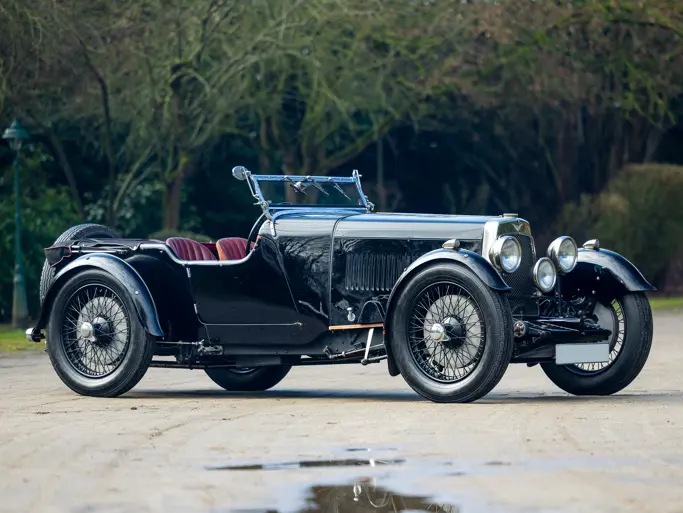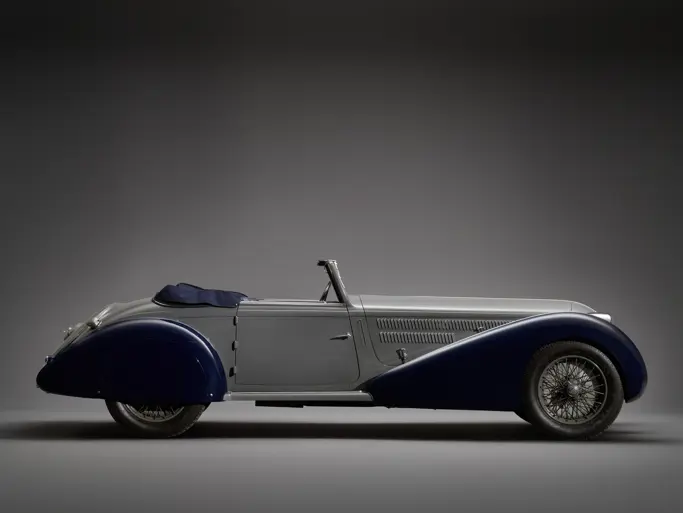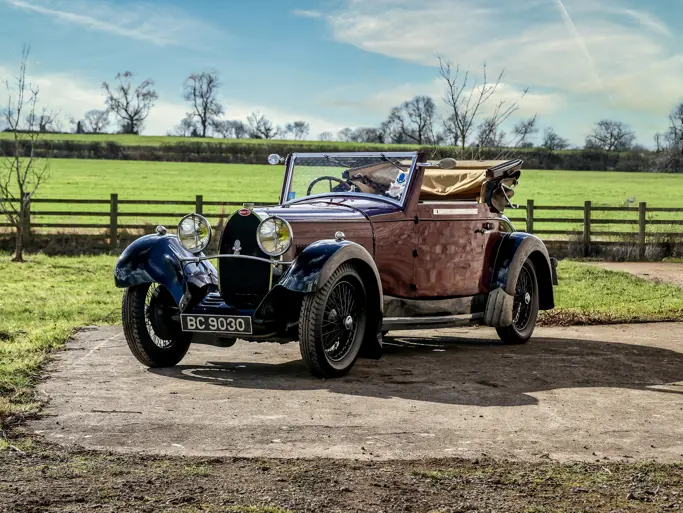Series 38-90. 185 hp, 431 cu. in. L-head V-16 engine, three-speed manual transmission, coil spring independent front suspension, live rear axle with semi-elliptic leaf springs, and four-wheel hydraulic drum brakes. Wheelbase: 141"
• One of only ten Convertible Coupes built
• Believed to have been owned new by Gary Cooper
• Stunning, Pebble Beach award-winning restoration
Cadillac’s second-generation V-16 was quite a departure from its predecessor. While the first generation Sixteen and its V-12 stable-mate had been 45-degree overhead valve designs, the new engine was a 135-degree L-head, developing 185 hp from 431 cubic inches. Each bank had its own distributor, carburetor and manifolds. The engine was six inches shorter, 13 inches lower and 250 pounds lighter than its overhead valve predecessor and had significantly fewer parts. Nevertheless, it developed the same power despite its smaller displacement.
Sharing chassis and bodies with the V-8-engined Series 75, the Series 90 Sixteen was offered in 14 body styles, all by Fleetwood, Cadillac’s in-house coachbuilding company. This sharing was enabled by the compact dimensions of the engine, which could be tucked under the firewall, permitting a shorter car without loss of interior space. Its styling was the work of William J. Mitchell, the young designer who had penned the dramatic Sixty Special. The V-16 was given a massive frontal appearance highlighted by a vertical die cast egg-crate grille, thrust forward almost to the bumper. The hood side panels, in a tribute to the 1933 V-16, had simple horizontal louvers which were repeated, in inverse order, on each of the four fenders. Side-mount spares were optional, but most cars had them, concealed under smooth metal covers. A new “goddess” hood ornament served double duty as the latch for the new “alligator” front-opening hood.
Catalogued body styles ran the gamut from two-passenger sport coupes and convertibles to five-passenger convertible sedans and from five-passenger sedans to the seven-passenger formal models. Prices ranged from $5,135 to $7,170, quite competitive with Lincoln’s flagship Model K and Packard’s Twelve, but more expensive than Pierce-Arrow’s offerings.
Cadillac built just 315 V-16s in 1938, of which just ten were convertible coupes. This one has long been associated with movie star Gary Cooper, including in Roy Schneider’s definitive book on the V-16 Cadillac, Sixteen Cylinder Motor Cars.
Given Cooper’s wealth, larger-than-life box office stature and personal interests, there were perhaps few men in Hollywood at the time better matched with such a grand automobile. Appearing in such renowned films as Meet John Doe, Sergeant York, Ball of Fire, Pride of the Yankees, For Whom the Bell Tolls and High Noon, Gary Cooper amassed largely unparalleled star power and wealth, becoming America’s highest paid entertainer in the late 1930s. With eclectic tastes ranging from skiing to horseback riding, Cooper also enjoyed luxurious and sporting automobiles, including one of just two short-wheelbase Duesenberg SSJs, the other of which was given to Clark Gable.
Cooper is said to have purchased the car at Hillcrest Motor Company on Wilshire Boulevard in Beverly Hills, commensurate with its build sheet that shows it invoiced to Don Lee, Inc., the Los Angeles distributor. Perhaps unusually for such an upscale car, it was ordered with few options, just the “Flex Wheel” (banjo-spoke steering wheel) it wears today and a set of license plate frames.
After remaining under the same ownership since the 1950s and reportedly having spent its entire life in southern California, this Cadillac V-16 eventually entered the esteemed collection of Larry Harvey. A show-quality, no-expense-spared restoration was completed some seven years ago by a noted expert. Spectacular and show quality in every respect, the car went on to win second in its class at the Pebble Beach Concours d’Elegance. Following its appearance at Pebble Beach, the astounding Cadillac was acquired by the Art Astor Collection, where it remained until its acquisition by the Milhous Collection.
Finished in a very handsome maroon, the stately exterior presents beautifully. The brightwork is all excellent, as is the tan convertible top. The interior is beautifully upholstered in tan leather and features two large jump seats in back, indicative of the Convertible Coupe body style, which has no rumble seat. The dashboard has excellent wood-grain, and the “Flex” steering wheel is nothing short of superb.
Showing barely 2,300 miles on its odometer, the car’s overall condition is commensurate with its Pebble Beach-quality restoration and the limited, periodic exercise it has received as part of the Astor and Milhous Collections. This Cadillac is bound to arouse the passions of cinemaphiles and classic car aficionados alike. In today’s collecting world, one will never find another.

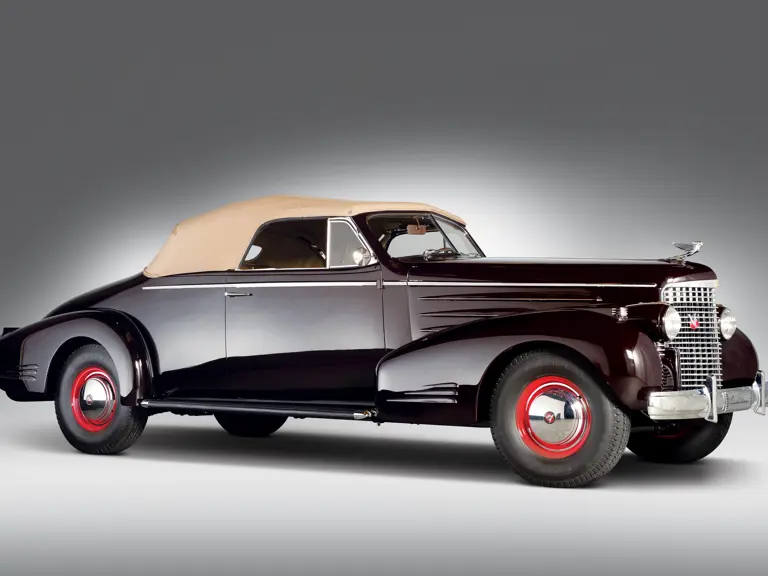
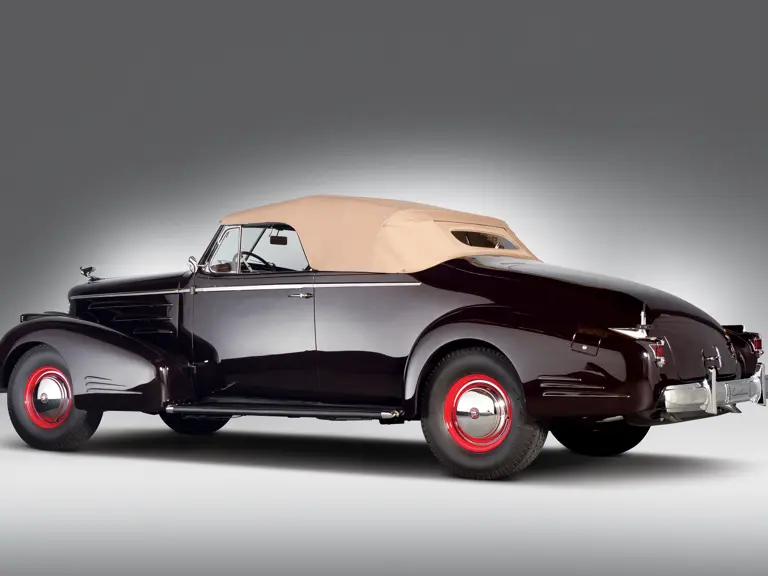

 | Boca Raton, Florida
| Boca Raton, Florida
